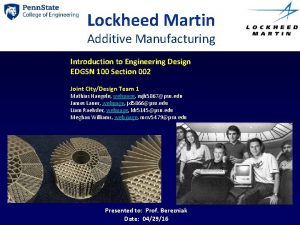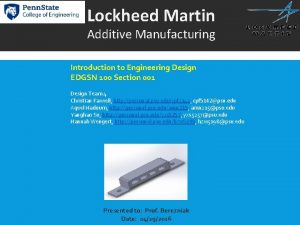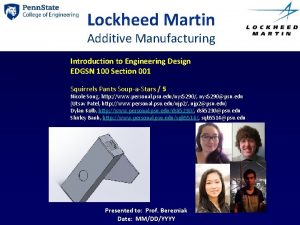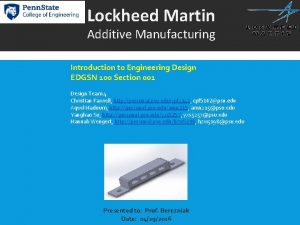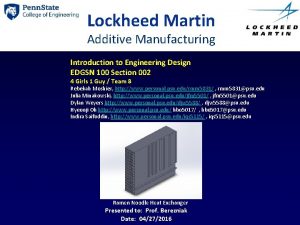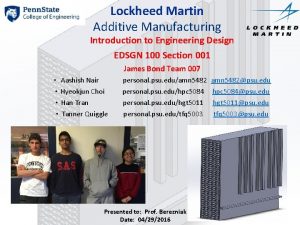Lockheed Martin Additive Manufacturing Introduction to Engineering Design










- Slides: 10

Lockheed Martin Additive Manufacturing Introduction to Engineering Design EDGSN 100 Section 002 4 Girls 1 Guy / Team 8 Rebekah Moshier, http: //www. personal. psu. edu/rmm 5831/ , rmm 5831@psu. edu Julia Minakowski, http: //www. personal. psu. edu/jfm 5501/ , jfm 5501@psu. edu Dylan Weyers http: //www. personal. psu. edu/djw 5588/ , djw 5588@psu. edu Hyeonji Oh http: //www. personal. psu. edu/ hbo 5017/ , hbo 5017@psu. edu Indira Saifuddin, http: //www. personal. psu. edu/iqs 5115/ , iqs 5115@psu. edu Ramen Noodle Heat Exchanger Presented to: Prof. Berezniak Date: 04/27/2016

Purpose • The purpose of this project was to redesign a traditionally manufactured air-flow through heat exchanger for additive manufacturing (AM) • Air-flow through heat exchangers utilize metals with favorable heat transfer coefficients and thin-fin structures to remove heat from circuit card assemblies (CCA) • Typically built using a combination of CNC milling and brazing • Methods can be expensive and time consuming • Redesign the heat exchanger to cut the lead time to several weeks

Background • Heat exchangers are used to remove heat and safe-guard components • Changed the inside design of the exchanger by arranging the slats in a vertical zig zag pattern • Also looked at the material the heat conductor was made from • Changed the material to the metal with the highest thermal conductivity

Sponsor • Headquartered in Bethesda, Maryland • 500 US facilities • Operates in 70 countries worldwide • Employs approximately 115, 000 people worldwide • 60, 000 engineers and scientists • Space systems, aeronautics, missile systems and training, missiles and fire control • Research, design, development, manufacture, integration and sustainment of advanced technology systems, products and services

Project Description Heat exchanger was picked because of the role in plays in our daily lives Heat exchangers are used on computers to remove heat Without the heat exchanger, the computers could be easily ruined Designed a heat exchanger using solid works then had it printed in the 3 D printing labs of Penn State • Also had to choose a proper AM process and material for the exchanger • Tried to achieve a heat designer that would better disperse heat and create a shorter build time • • Original vs New Design

Procedures (1 of 2) • Heat exchanger was modified in three ways • The inside design was changed • The material of the heat exchanger was changed • The thickness of the inside parts were decreased • The inside slats were changed from horizontal to vertical • The slats were also changed from a straight line into a zig zag pattern • Allows more heat to dissipate at a faster rate preventing the components from overheating

Procedures (2 of 2) • The material was changed to copper • • • Copper has a high thermal conductivity of 386 W/m ˚C Relatively low price of $2. 28 per pound About $. 006 per 1 unit of thermal conductivity Copper allows heat to pass through it quickly Also conducts heat quickly and distributes it evenly • Thickness of the slats was changed from. 1 in to. 025 inches • Smaller thickness results in less material and a lower price

Results and Discussion • Heat exchanger was designed to model after the small intestines • Increased surface area allows more nutrients to be absorbed • Increasing the area allows more energy to be dissipated • According to noted thermodynamic researchers, Sang-Moon Lee and Kwang-Yong Kim • “…shape optimization of zigzag flow channels in a PCHE has been performed to enhance heat transfer performance and reduce the friction loss based on three-dimensional Reynolds-averaged Navier– Stokes analysis with the Shear Stress Transport Turbulence model” • Overall, this new design allows air to flow more efficiently and effectively

Conclusions and Recommendations • The vertical zig zag design would create a more efficient heat exchanger than the original • The design allows air to travel more effectively through the exchanger • While the zig zag design was a good start, a few alterations could be added to improve the design • The zig zags could have been made horizontal • Heat would travel a shorter distance, thus creating a more efficient heat exchanger

Closing Acknowledgements Team 8 would like to thank Lockheed Martin for the amazing opportunity. Team 8 would also like to thank Professor Berezniak for all the help on this project. Finally, Team 8 would like to thank Logan Fries and Matt Schoffelemer for their assistance on the project. This project is dedicated to Oliver; he dropped this class before we got to meet him, but we’re sure he would have been a great addition to the group.











